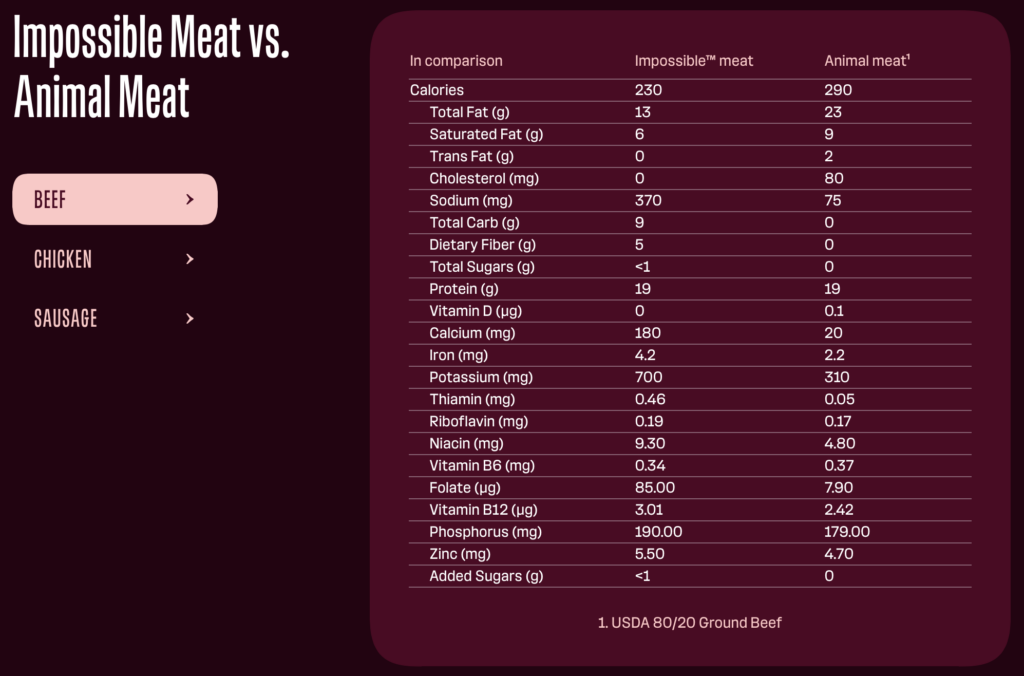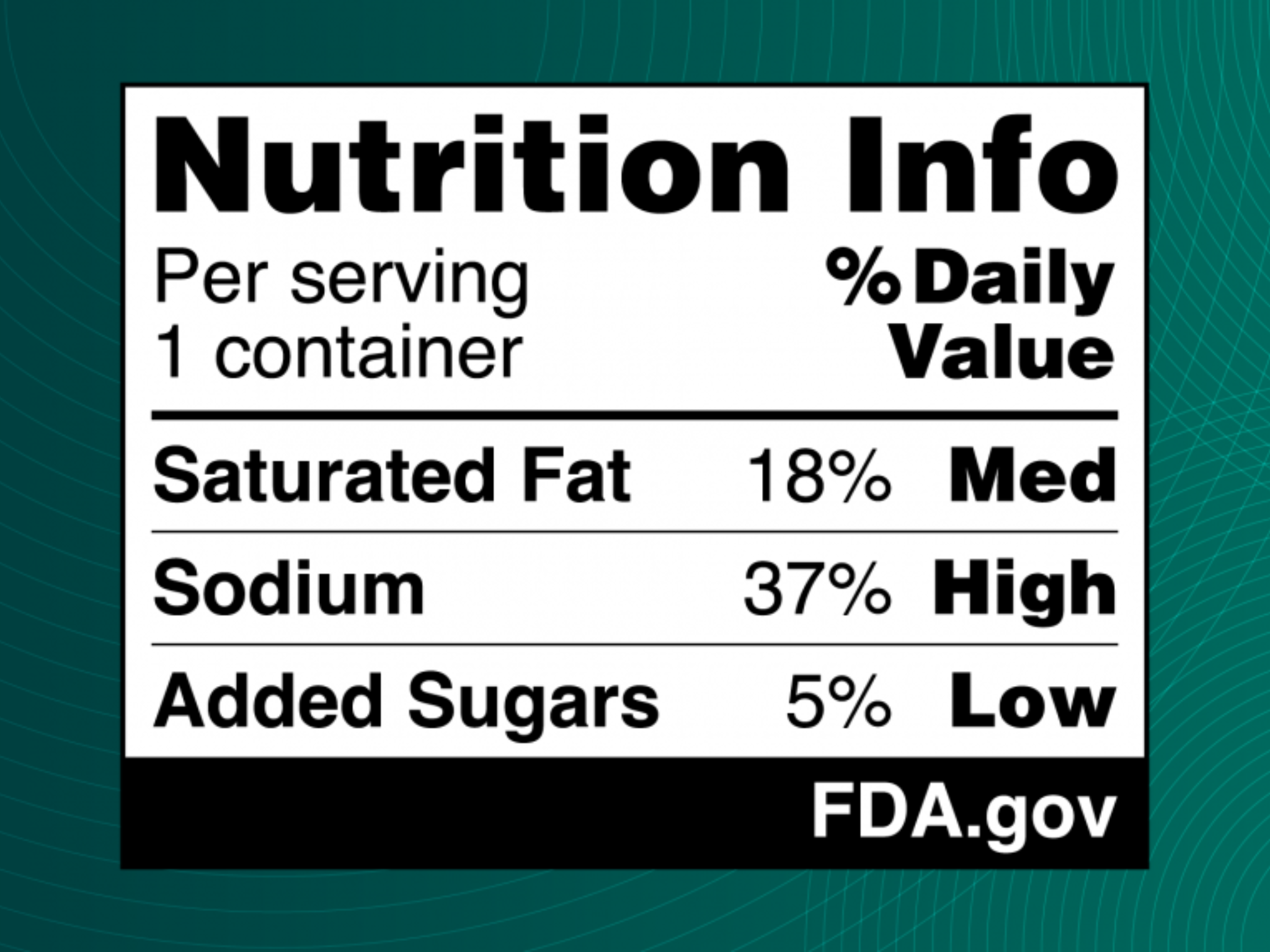4 Mins Read
The FDA has proposed new front-of-pack labelling rules for packaged foods, which would highlight saturated fat, sodium, and added sugars – could it be a boon for plant-based meat?
Would a “high saturated fat” label deter you from buying a food product?
It’s what the US Food and Drug Administration is banking on in its latest proposal, which would require a front-of-package nutrition label on packaged foods that provides “at-a-glance nutrition information” to help Americans make more informed choices about their diets and health.
The proposed Nutrition Info box is designed to complement the FDA’s back-of-pack Nutrition Facts label, and would focus on three problematic nutrition measures: saturated fat, sodium and added sugars. Alongside a numerical percentage of the daily recommended value, the label will also show whether the food has low (5% or less of the daily value), medium (6-19%) or high levels (20% or higher) of these nutrients.
When consumed in excess, salt, sugar and saturated fat are directly linked with increased chronic disease risk, which is why the federal dietary guidelines advise Americans to limit these nutrients. And while calories aren’t mandated on the Nutrition Info box, manufacturers can choose to declare them voluntarily.
Why is the FDA proposing the Nutrition Info box?
The Nutrition Info box is part of the White House National Strategy on Hunger, Nutrition and Health, which aims to reduce diet-induced diseases by 2030.
Three in five Americans have at least one chronic disease, including heart disease, cancer and diabetes – these are the leading cause of disability and death in the US, and rack up $4.5T in annual healthcare costs.
In 2023, the FDA conducted a study of nearly 10,000 American adults to determine their response to three different types of front-of-pack labels, and found that the black-and-white Nutrition Info scheme with the daily value in percentage performs best in helping participants identify healthier food options.
“Nearly everyone knows or cares for someone with a chronic disease that is due, in part, to the food we eat,” said FDA commissioner Robert M Califf. “It is time we make it easier for consumers to glance, grab and go. Adding front-of-package nutrition labeling to most packaged foods would do that.
“We are fully committed to pulling all the levers available to the FDA to make nutrition information readily accessible as part of our efforts to promote public health.”
The FDA also highlighted that these nutrients are found in foods commonly considered ultra-processed, of which there has been a proliferation in recent years. These products are increasingly coming under political fire.
Is this a win for plant-based meat?

Plant-based meat brands don’t need to worry about the added sugar content, seeing as most products have a negligible amount of free sugars.
Where meat analogues would outshine their animal counterparts is on the saturated fat content. For example, a Beyond Burger patty, with 10% of the daily recommended value, would feature a medium rating, while a regular hamburger with 25% of the value would have a high rating.
Similarly, a serving of regular bacon would have a medium rating, while MorningStar Farms’s vegan bacon would retain a low rating on the front-of-package label. Daring’s vegan chicken, meanwhile, has zero unsaturated fat, compared to 2.7g for conventional chicken, which would put it in the medium category.
Meat alternatives could also suffer from the Nutrition Info box with the sodium label, given that this has long been a point of criticism against vegan products.
Take Impossible Beef, for example, which has nearly five times as much sodium as conventional 80/20 beef mince. A mycelium steak from Meati will take up 28% of your daily sodium budget.
This is the case with many popular plant-based meat offerings. However, these products are pre-seasoned, unlike most of the conventional meats they’re compared to.
It’s an argument nutritionists make regularly in defence of plant-based meats, not least Dr Michael Greger, author of How Not to Die. In a recent seminar, he suggested that when comparing like-for-like, the saltiest plant-based meatballs have been found to be lower in sodium than the least salty conventional meatballs.
The FDA’s Nutrition Info label’s current suggested design means plant-based meat may be penalized by consumers on the sodium front, with most products receiving a high rating on the front of the packaging.
What happens next?

The FDA has opened the proposal up to public comments, which can be submitted until May 16. If finalised, the rule would require manufacturers to add a Nutrition Info box to products three years after its effective date for businesses with annual food sales of $10M or higher, and four years after for companies with sales under $10M.
This is one of several measures the FDA has taken to reduce diet-related diseases in the US – it has worked to develop a ‘healthy’ symbol on packaging, drafted an update to sodium reduction targets, and updated its ‘healthy’ claim on food labels.
“Food should be a vehicle for wellness, not a contributor of chronic disease,” said Jim Jones, FDA’s deputy commissioner for human foods. “In addition to our goal of providing information to consumers, it’s possible we’ll see manufacturers reformulate products to be healthier in response to front-of-package nutrition labeling.”
“Together, we hope the FDA’s efforts, alongside those of our federal partners, will start stemming the tide of the chronic disease crisis in our country.”



